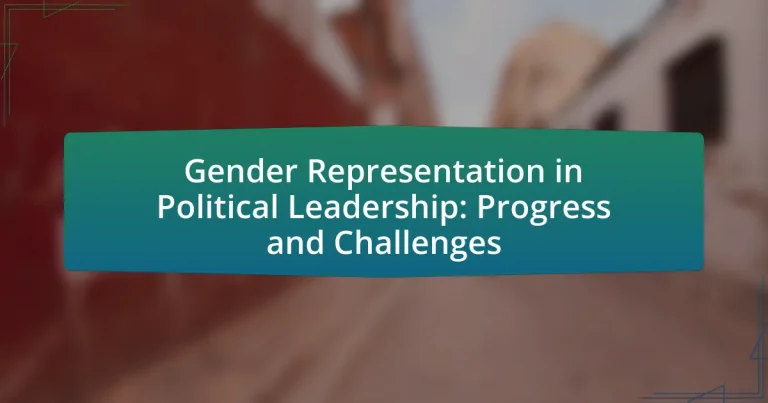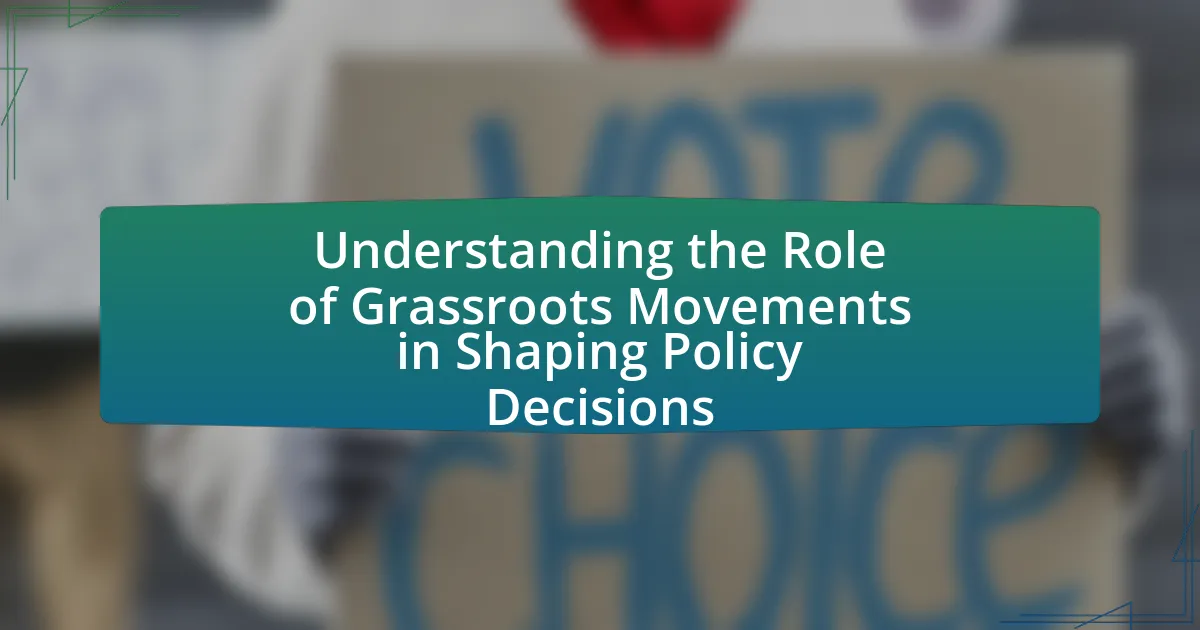Gender representation in political leadership refers to the equitable participation of individuals of different genders, particularly women, in decision-making roles within political institutions. The article examines the importance of gender representation, highlighting its impact on governance, policy-making, and societal outcomes. It discusses historical contexts, current statistics, and challenges faced in achieving gender parity, as well as successful strategies for improvement, such as gender quotas and mentorship programs. Additionally, the article explores the role of technology and social media in promoting gender representation and outlines practical steps individuals and organizations can take to support this cause.
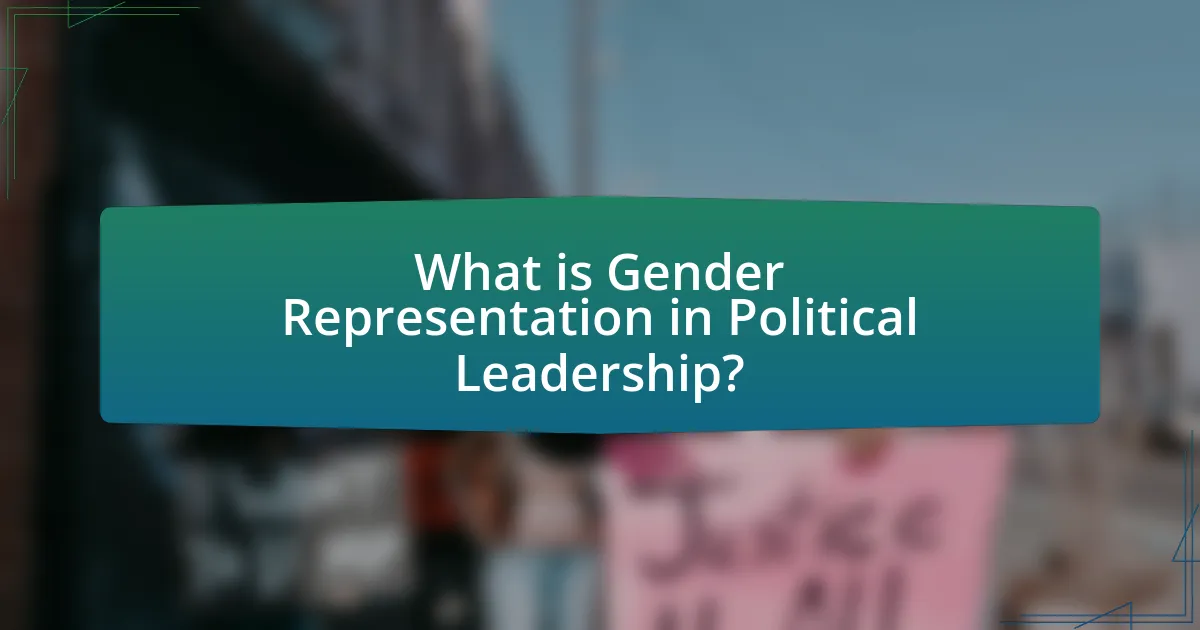
What is Gender Representation in Political Leadership?
Gender representation in political leadership refers to the equitable participation of individuals of different genders, particularly women, in decision-making roles within political institutions. This representation is crucial for ensuring that diverse perspectives and experiences are included in governance, which can lead to more comprehensive and effective policy-making. For instance, as of 2021, women held approximately 26% of parliamentary seats globally, highlighting ongoing disparities in gender representation. Studies have shown that increased female representation can lead to more attention to issues such as healthcare, education, and gender equality, thereby reinforcing the importance of achieving gender parity in political leadership.
Why is Gender Representation important in Political Leadership?
Gender representation is important in political leadership because it ensures diverse perspectives and experiences are included in decision-making processes. Studies show that when women are represented in political offices, policies tend to be more inclusive and address issues such as healthcare, education, and social welfare more effectively. For instance, research by the Inter-Parliamentary Union indicates that countries with higher female representation in parliament often see improved legislative outcomes related to gender equality and social justice. This correlation highlights the necessity of gender representation in fostering equitable governance and enhancing the overall effectiveness of political systems.
What historical context influences current Gender Representation in Political Leadership?
Historical context significantly influences current gender representation in political leadership, primarily shaped by women’s suffrage movements and legislative reforms. The early 20th century saw pivotal milestones, such as the 19th Amendment in the United States, which granted women the right to vote in 1920, marking a crucial step toward political inclusion. Additionally, global movements for gender equality, such as the United Nations’ 1979 Convention on the Elimination of All Forms of Discrimination Against Women, have established frameworks that encourage women’s participation in politics. These historical developments have laid the groundwork for contemporary policies aimed at increasing female representation, evidenced by the rise in women holding political office worldwide, which reached approximately 26% in national parliaments by 2021, according to the Inter-Parliamentary Union.
How does Gender Representation impact governance and policy-making?
Gender representation significantly impacts governance and policy-making by promoting diverse perspectives and enhancing decision-making processes. When women are represented in political leadership, policies tend to address a broader range of issues, including those affecting marginalized groups. Research indicates that countries with higher female representation in parliament, such as Rwanda, which has the highest percentage of women in government globally at over 60%, often see improved social outcomes, including better healthcare and education policies. Furthermore, studies show that gender-diverse leadership teams are more effective in problem-solving and innovation, leading to more comprehensive and effective governance.
What are the current statistics on Gender Representation in Political Leadership?
As of 2023, women hold approximately 26% of parliamentary seats globally, reflecting a gradual increase in gender representation in political leadership. This statistic indicates that while progress has been made, significant disparities remain. For instance, only 10 countries have achieved 50% or more female representation in their national parliaments. Additionally, women occupy around 22% of ministerial positions worldwide, highlighting ongoing challenges in achieving gender parity in political leadership roles. These figures are sourced from the Inter-Parliamentary Union and UN Women, which regularly track and report on gender representation in politics.
How do different countries compare in terms of Gender Representation?
Countries vary significantly in gender representation, with Nordic countries like Iceland, Finland, and Norway leading in political leadership roles for women, often exceeding 40% representation in parliaments. In contrast, countries such as Japan and the United States show lower figures, with women holding approximately 10% and 27% of parliamentary seats, respectively. The Global Gender Gap Report 2021 by the World Economic Forum highlights these disparities, indicating that while some nations have made substantial progress, others lag behind due to cultural, social, and political barriers.
What trends have emerged in Gender Representation over the past decades?
Over the past decades, significant trends in gender representation have emerged, particularly in political leadership roles. The proportion of women in political positions has steadily increased, with global averages showing that women’s representation in national parliaments rose from 11% in 1995 to approximately 25% in 2021, according to the Inter-Parliamentary Union. Additionally, countries like Rwanda have achieved over 60% female representation in their lower house, setting a global benchmark. However, challenges remain, as women still face systemic barriers, including gender bias and underrepresentation in decision-making processes. These trends indicate both progress and ongoing obstacles in achieving gender parity in political leadership.
What challenges exist in achieving Gender Representation in Political Leadership?
Achieving gender representation in political leadership faces several challenges, including systemic barriers, cultural norms, and institutional biases. Systemic barriers such as unequal access to resources and networks hinder women’s participation in politics. Cultural norms often perpetuate stereotypes that discourage women from seeking leadership roles, while institutional biases within political parties and electoral systems can limit opportunities for women candidates. For instance, a study by the Inter-Parliamentary Union found that women hold only 26.1% of parliamentary seats globally, indicating significant underrepresentation. These factors collectively create an environment that impedes gender parity in political leadership.
What societal attitudes hinder Gender Representation in Political Leadership?
Societal attitudes that hinder gender representation in political leadership include pervasive stereotypes about gender roles, biases that associate leadership with masculinity, and the undervaluation of women’s contributions. These attitudes manifest in various ways, such as the belief that women are less competent in decision-making roles, which is supported by studies indicating that women face higher scrutiny and lower expectations compared to their male counterparts. Additionally, cultural norms often prioritize male leadership, leading to fewer opportunities for women to be elected or appointed to leadership positions. Research from the Inter-Parliamentary Union shows that countries with strong gender stereotypes tend to have lower percentages of women in political offices, highlighting the direct impact of societal attitudes on gender representation in political leadership.
How do institutional barriers affect Gender Representation?
Institutional barriers significantly hinder gender representation by creating systemic obstacles that limit women’s access to leadership roles. These barriers include discriminatory policies, lack of supportive networks, and inadequate resources for women candidates. For instance, research by the Inter-Parliamentary Union indicates that countries with gender quotas see a 20-30% increase in women’s representation in political offices, demonstrating how institutional frameworks can either facilitate or obstruct gender equity. Additionally, the World Economic Forum’s Global Gender Gap Report highlights that countries with strong legal frameworks promoting gender equality tend to have higher female representation in leadership positions, further validating the impact of institutional barriers on gender representation.
How can we improve Gender Representation in Political Leadership?
To improve gender representation in political leadership, implementing gender quotas is an effective strategy. Research shows that countries with gender quotas, such as Rwanda, have achieved significant increases in women’s representation in parliament, reaching over 60% female members. Additionally, promoting mentorship programs for women in politics can enhance their leadership skills and confidence, as evidenced by initiatives like the Women in Public Service Project, which has successfully trained women leaders globally. Furthermore, increasing public awareness and support for gender equality in politics through campaigns can shift societal attitudes, leading to greater acceptance of women in leadership roles.
What role do political parties play in enhancing Gender Representation?
Political parties play a crucial role in enhancing gender representation by establishing policies and practices that promote the inclusion of women in political leadership positions. They can implement gender quotas, which have been shown to increase the number of women candidates and elected officials; for instance, countries like Rwanda have achieved over 60% female representation in parliament through such measures. Additionally, political parties can provide training and resources to support women candidates, fostering an environment that encourages female participation in politics. Research indicates that parties with strong gender equality policies are more likely to nominate women, thereby directly impacting the overall representation of women in governance.
How can education and advocacy contribute to better Gender Representation?
Education and advocacy can significantly enhance gender representation by equipping individuals with knowledge and skills while promoting awareness of gender issues. Education fosters critical thinking and empowers individuals to challenge stereotypes and biases, which is essential for increasing women’s participation in political leadership. For instance, programs that focus on leadership training for women have been shown to increase their representation in decision-making roles. Advocacy campaigns raise public awareness and influence policy changes that support gender equality, such as implementing quotas for women in political positions. Research from the Inter-Parliamentary Union indicates that countries with gender quotas have seen an increase in women’s representation in parliament, demonstrating the effectiveness of advocacy in creating systemic change.
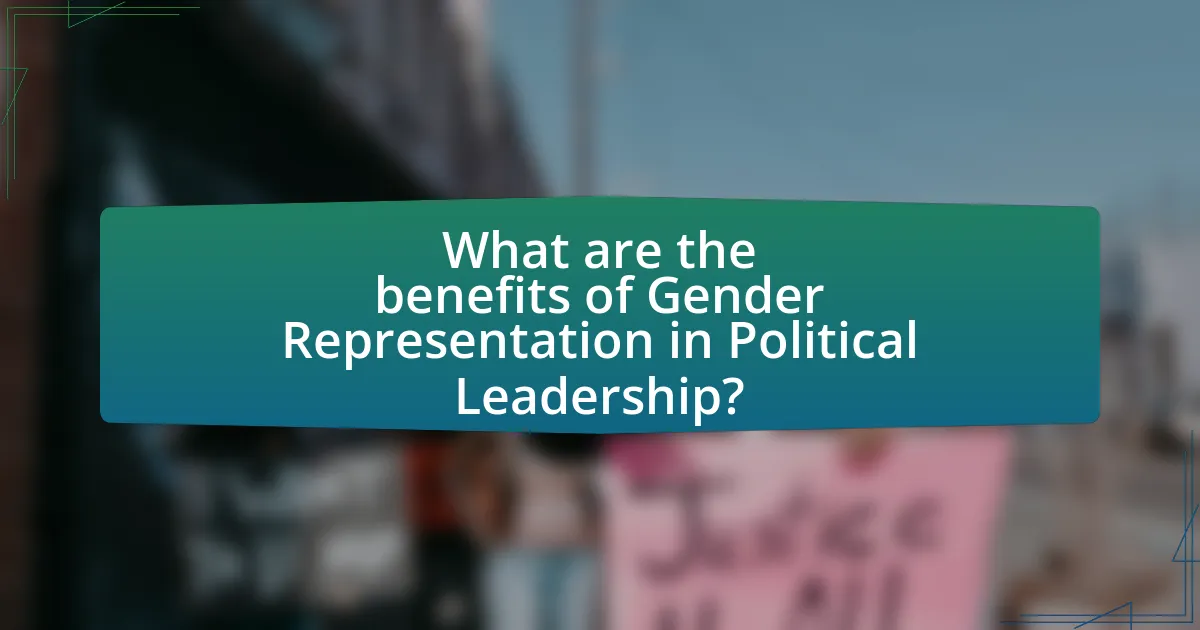
What are the benefits of Gender Representation in Political Leadership?
Gender representation in political leadership enhances decision-making and governance by incorporating diverse perspectives. Studies show that women in leadership roles contribute to more inclusive policies, improved social outcomes, and increased public trust. For instance, research published in the American Economic Journal indicates that countries with higher female political representation experience lower levels of corruption and better health and education outcomes. Furthermore, gender-diverse leadership teams are associated with more innovative solutions and effective problem-solving, as they draw from a wider range of experiences and viewpoints.
How does Gender Representation influence decision-making processes?
Gender representation significantly influences decision-making processes by promoting diverse perspectives and enhancing the quality of decisions. Research indicates that organizations with higher gender diversity in leadership roles tend to make more effective decisions, as diverse teams are better at problem-solving and innovation. For instance, a study by McKinsey & Company found that companies in the top quartile for gender diversity on executive teams were 21% more likely to experience above-average profitability compared to those in the bottom quartile. This correlation suggests that gender representation not only impacts the inclusivity of the decision-making process but also contributes to improved organizational performance.
What positive outcomes have been observed in countries with higher Gender Representation?
Countries with higher gender representation have observed improved governance and enhanced economic performance. For instance, research indicates that nations with more women in leadership roles tend to experience lower levels of corruption, as diverse leadership fosters accountability and transparency. Additionally, the McKinsey Global Institute reported that closing gender gaps in labor force participation could add $28 trillion to global GDP by 2025, highlighting the economic benefits of gender diversity. Furthermore, studies show that increased female representation in politics leads to policies that better address women’s issues, resulting in improved health and education outcomes for communities.
How does Gender Representation affect public trust in political institutions?
Gender representation significantly affects public trust in political institutions by enhancing perceptions of legitimacy and inclusivity. Research indicates that when women are represented in political leadership, it fosters a sense of fairness and responsiveness among constituents, leading to increased trust. For instance, a study published in the American Political Science Review found that higher levels of female representation correlate with greater public trust in government, particularly among women voters. This effect is attributed to the belief that diverse leadership better reflects the population’s interests and experiences, thereby improving the overall credibility of political institutions.
What strategies have been successful in promoting Gender Representation?
Successful strategies for promoting gender representation include implementing gender quotas, providing mentorship programs, and fostering inclusive workplace cultures. Gender quotas, such as those adopted in countries like Rwanda, have led to significant increases in women’s political participation, with Rwanda achieving over 60% female representation in its parliament. Mentorship programs, like those initiated by organizations such as Lean In, empower women by connecting them with experienced leaders who can guide their career development. Additionally, creating inclusive workplace cultures that prioritize diversity and equity has been shown to enhance women’s representation in leadership roles, as evidenced by research from McKinsey & Company, which found that companies with diverse leadership teams are 21% more likely to outperform their peers in profitability.
What initiatives have proven effective in increasing women’s participation in politics?
Quotas and gender parity laws have proven effective in increasing women’s participation in politics. Countries implementing gender quotas, such as Rwanda, which has the highest percentage of women in parliament globally at over 60%, demonstrate that legislative measures can significantly enhance female representation. Additionally, initiatives like training programs for women candidates and mentorship schemes have shown success in empowering women to run for office, as evidenced by the success of organizations like EMILY’s List in the United States, which has helped elect thousands of women to political positions since its inception.
How can mentorship programs support aspiring female leaders?
Mentorship programs can support aspiring female leaders by providing guidance, networking opportunities, and skill development tailored to their unique challenges. These programs connect women with experienced mentors who can share insights on navigating political landscapes, enhancing leadership skills, and building confidence. Research indicates that women with mentors are more likely to pursue leadership roles; for example, a study by the American Council on Education found that 63% of women in leadership positions credited mentorship as a key factor in their career advancement. This evidence underscores the effectiveness of mentorship in fostering female leadership in political contexts.
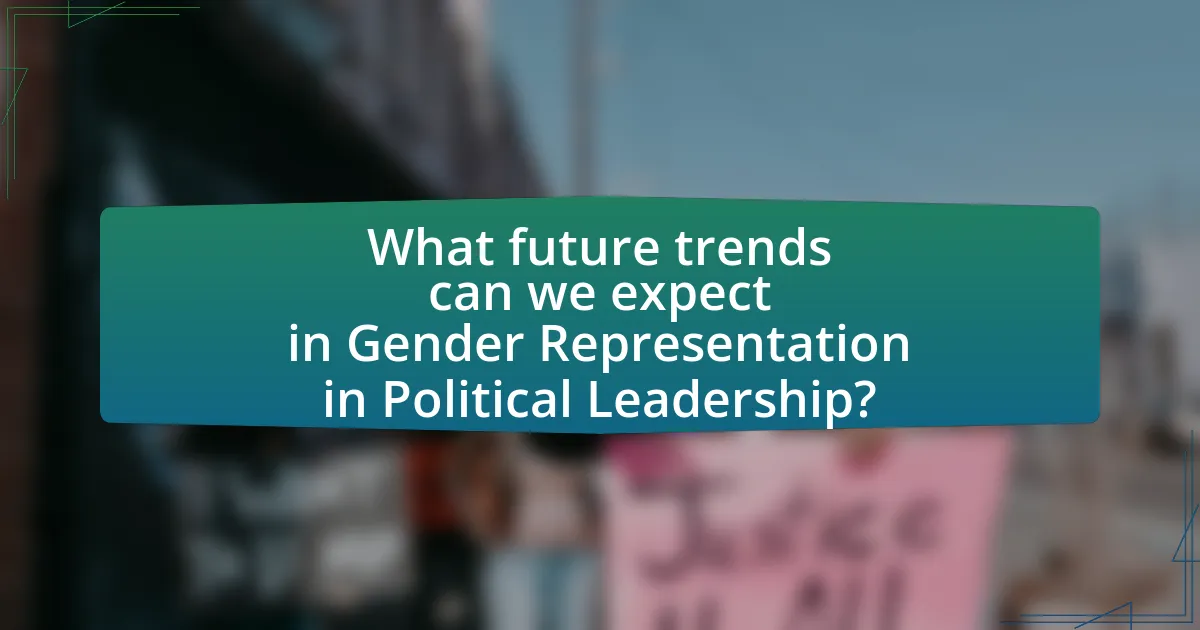
What future trends can we expect in Gender Representation in Political Leadership?
Future trends in gender representation in political leadership indicate an increase in women’s participation and leadership roles, driven by societal shifts and policy changes. Research shows that countries with gender quotas, such as Rwanda, have seen significant increases in female representation, with women holding 61% of parliamentary seats as of 2021. Additionally, global movements advocating for gender equality, like the #MeToo movement, are influencing political landscapes, encouraging more women to run for office. Furthermore, studies suggest that younger generations prioritize diversity in leadership, which may lead to more equitable representation in the coming years.
How is technology influencing Gender Representation in politics?
Technology is significantly influencing gender representation in politics by enhancing visibility and accessibility for women candidates. Digital platforms, such as social media, allow women to reach broader audiences, engage with constituents, and mobilize support more effectively than traditional methods. For instance, a study by the Pew Research Center in 2020 found that women politicians who utilized social media platforms experienced increased engagement and support, which contributed to their electoral success. Additionally, technology facilitates online fundraising, enabling women to compete more equitably with male counterparts who may have historically dominated financial backing in political campaigns. This shift in dynamics is evidenced by the rise of women in leadership positions, with the Inter-Parliamentary Union reporting that as of 2021, women held 25.5% of parliamentary seats globally, a figure that has been positively impacted by technological advancements in campaigning and outreach.
What role do social media and digital platforms play in promoting Gender Representation?
Social media and digital platforms significantly enhance gender representation by providing accessible channels for diverse voices and facilitating engagement in political discourse. These platforms enable women and marginalized groups to share their experiences, advocate for their rights, and mobilize support for gender equality initiatives. For instance, campaigns like #MeToo and #TimesUp have utilized social media to raise awareness about gender-based violence and discrimination, leading to increased visibility and support for women’s issues. Research indicates that women who engage on these platforms can influence public opinion and policy discussions, thereby contributing to a more balanced representation in political leadership.
How can data analytics help track progress in Gender Representation?
Data analytics can help track progress in gender representation by providing measurable insights into the demographic composition of political leadership roles. By analyzing data sets that include gender, position, and tenure, organizations can identify trends, gaps, and improvements in gender representation over time. For instance, a study by the Inter-Parliamentary Union in 2021 revealed that countries with robust data analytics frameworks saw a 10% increase in women’s representation in parliament over five years, demonstrating the effectiveness of data-driven strategies in promoting gender equity. This analytical approach allows stakeholders to make informed decisions, implement targeted interventions, and assess the impact of policies aimed at enhancing gender representation in political leadership.
What practical steps can individuals take to support Gender Representation in Political Leadership?
Individuals can support gender representation in political leadership by actively advocating for policies that promote gender equality, such as gender quotas in political parties. Research shows that countries with gender quotas have seen a significant increase in women’s representation; for example, Rwanda has the highest percentage of women in parliament globally, at 61%, largely due to such policies. Additionally, individuals can engage in grassroots campaigns to raise awareness about the importance of female leadership and encourage women to run for office. Supporting organizations that focus on training women for political roles, like Running Start, can also enhance women’s participation in politics. By voting for candidates who prioritize gender equality and participating in community discussions about women’s issues, individuals can further contribute to a political landscape that values diverse representation.
How can voters influence Gender Representation through their choices?
Voters can influence gender representation by selecting candidates who prioritize gender equity and diversity in their platforms. When voters actively support female candidates or those committed to promoting women’s issues, they help to increase the number of women in political leadership roles. For instance, research shows that countries with higher female voter turnout tend to elect more women to office, as seen in the 2018 U.S. midterm elections where a record number of women were elected, largely due to increased voter engagement around gender issues. This demonstrates that informed voting choices can directly impact the representation of women in politics.
What actions can community organizations take to advocate for Gender Representation?
Community organizations can advocate for gender representation by implementing targeted outreach programs that educate and empower women to participate in political processes. These organizations can host workshops and training sessions focused on leadership skills, public speaking, and campaign strategies, which have been shown to increase women’s candidacy rates. For instance, research from the Inter-Parliamentary Union indicates that countries with active civil society engagement in promoting women’s political participation see a higher percentage of women in leadership roles. Additionally, community organizations can collaborate with local governments to create policies that support gender quotas, ensuring a minimum representation of women in political offices. This approach has been effective in various countries, leading to significant increases in female representation in legislative bodies.
